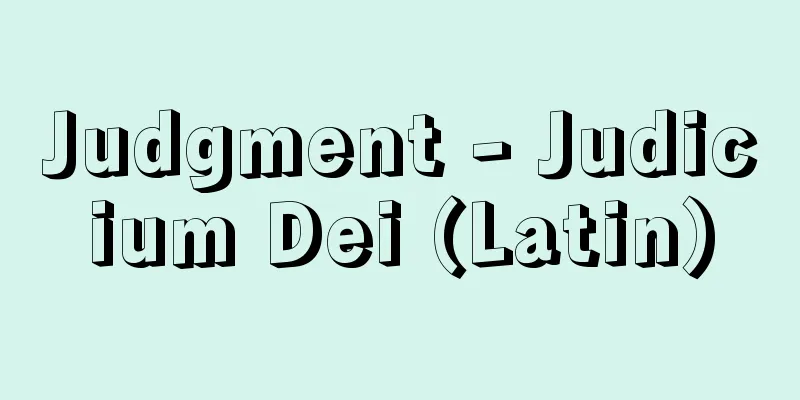Judgment - Judicium Dei (Latin)

|
A judicial method that appeals to supernatural authority such as God to determine the rightness or wrongness of actions and the truth or falsehood of words. Various means and methods for determining divine will are found all over the world. Usually the means themselves actually cause physical damage or are fatal, and sometimes the proof of guilt is itself a punishment, but some simply depend on chance. The following various methods of divine trial were used in ancient European law. In a fire trial, the accused was made to hold a red-hot iron, walk barefoot over a fire, or put his hands in boiling water to see if they were burned. If they were not burned, they were found not guilty. In a sacrament trial, the priest put consecrated bread into the accused's mouth while saying a prayer. If the accused swallowed it, he was found not guilty, if he spat it out or got caught in the process, he was found guilty. A bier trial was used in cases of murder. The murdered person was placed on a bier and the accused touched the body. If the body bled, foamed at the mouth, or changed position, the person was found guilty. Other methods of trial included the loser of a duel being found guilty, and the drawing of lots was also used. In India, the ancient legal codes of Manu and Narada also record the following methods, along with trials by fire and water. The suspect would be weighed twice, and the difference in weight before and after would determine whether or not he was guilty. For example, the suspect would be given poison and the determination would be made as to whether or not he was poisoned. In China, there were also trials using poisonous snakes and boiled oil. There was also a one-horned animal that resembled a goat, which is said to have been used to detect those who were lying during trials. In ancient Japan, there was a method called "kukatachi" in which a person was forced to put his hand in boiling water to determine whether or not he was burned, and the crime he committed was judged based on this. Records show that a method similar to this, "yugisho," was used in the Muromachi period. In Japan, some form of divine judgment was still used in the Edo period. In Europe, the Lateran Council of 1215 prohibited clergy from attending trials, and divine trials officially lost their legitimacy. After this, divine trials gradually fell out of use as the judicial system developed. However, during the storm of witch-hunting that swept across Europe from the 14th to 16th centuries, divine trials were revived. Various methods were established to prove witchcraft, and the most common was the water trial. In this method, the accused was stripped naked, tied the thumb of his right hand to the big toe of his left foot, and the thumb of his left hand to the big toe of his right foot, and then thrown into a pond or river. Submerging in the water was considered proof of innocence, while floating was considered proof of guilt, but innocence often meant drowning, and if the person floated and avoided drowning, they were hanged as a witch. This method of trial was still used in England into the 18th century. In Africa, divine trial was also widely used to determine witchcraft. For example, the Lele agricultural people of the Democratic Republic of the Congo (formerly Zaire) used a poison extracted from the bark of a certain tree. If an accused witch drank it and spat it out, he was innocent; if he died, he was found guilty. Rather than each time a suspected witch drank the poison, all the suspects drank it together after a certain period of time. Among the Nyakyusa agricultural people living on the north side of Lake Malawi, both the accuser and the accused drank the poison. In this case, both parties could appoint a proxy, and the one who was best at spat it out became the proxy. Such trial methods were completely banned by the colonial government in the early 20th century. As a result, some societies felt that witchcraft had increased and become rampant. However, although poison and hot iron are no longer used, the idea of divine trial lives on. For example, among the East African agricultural people, the Meru, accusers and accused people still curse each other in a "curse pit" managed by a group of elders. It is believed that the person who tells a lie and his or her relatives will die one after another. [Yasushi Kato] Source: Shogakukan Encyclopedia Nipponica About Encyclopedia Nipponica Information | Legend |
|
神などの超自然的権威に訴えて、行為の正邪、ことばの真偽を判定する裁判方法。神意を判定するためのさまざまな手段・方法が世界各地にみられる。普通はその手段自体が現実に物理的被害を与えたり致命的だったりするものが多く、ときには罪の証明がそれ自体罰になるが、単に偶然性に依存しているものもある。次のようなさまざまな神判の方法がヨーロッパの古法において用いられた。 火神判では赤熱した鉄をつかませたり、裸足で火の上を歩かせたり、また熱湯の中に手を入れさせ火傷の有無を調べた。もし火傷をしていなかったなら無罪とされたのである。聖餐(せいさん)神判では司祭が祈りのことばとともに被告発者の口の中に聖別されたパンを入れた。もしもその人物がそれを飲み込んだなら無罪とされ、吐き出したり途中でひっかかったりしたなら有罪とされた。棺台の神判は殺人の場合に用いられた。殺害された人が棺台の上に置かれ、被告発者がその体に触る。もし死体から血が流れ出たり、口から泡を出したりした場合、または死体の位置が変わったりしたならその人物は有罪とされた。このほかにも決闘で負けたほうが有罪とされたり、くじ引きもまた神判の方法として用いられた。 インドでもマヌやナラダの古代法典に火神判や水神判とともに次のような方法が記されている。被疑者の体重を2回量り、前後の計量の差異により罪の有無を判定する。毒を飲ませ中毒の有無により判定するなど。中国でも毒蛇や煮えた油を用いた神判があった。またヤギに似た一角の動物が存在し、これが裁判のとき嘘(うそ)をついている者を発見したという。 古代日本では熱湯に手を入れさせ火傷の有無で罪を判定する盟神探湯(くかたち)があった。これとほぼ同じ方法の湯起請(ゆぎしょう)が室町時代に行われたと記録にある。日本では神判のあるものは江戸時代に入っても行われていた。 ヨーロッパでは1215年のラテラン公会議で聖職者の神判立会いが禁止され、公的には神判は正当性を失った。これ以後裁判制度の発展とともに神判は徐々に行われなくなる。しかし14世紀から16世紀までヨーロッパに吹き荒れた魔女狩りの嵐(あらし)のなかで神判による試罪法が復活した。魔女であることを証明するさまざまな方法が確立されたが、そのなかでもとくに水神判が用いられた。これは、魔女として告発された者を裸にし、右手の親指を左足の親指に、左手の親指を右足の親指に結び付けて池や川の中に投げ込むのである。水中に沈めば無罪、浮かべば有罪の証拠であるとみなされたが、無罪となることはしばしばそのまま溺死(できし)することであり、浮かんで溺死を免れれば魔女として絞首刑に付されるのである。この試罪法はイングランドでは18世紀に入ってもなお用いられたという。 アフリカでも妖術(ようじゅつ)者の判定に神判が広く用いられた。たとえばコンゴ民主共和国(旧ザイール)に住む農耕民レレでは、ある樹皮からとった毒が使用された。妖術者として告発された者がこれを飲んで吐き出したら無罪、死んだら有罪とされた。妖術者の嫌疑を受けた者たちはそのたびに毒を飲むのではなく、ある一定の期間を置いてすべての被疑者がいっしょに毒を飲んだという。マラウイ湖北側に住む農耕民ニャキュサでは告発した側と告発された側がともに毒を飲んだ。ここでは双方とも代理の者をたてることができ、吐き出すのがうまい者が代理になったという。こうした試罪法は植民地政府により20世紀初頭には全面的に禁止された。その結果、妖術者が増え、はびこることになったと感じた社会もある。しかし、毒や焼いた鉄などは用いられなくなったが神判の思想は生き続け、たとえば東アフリカの農耕民メルでは現在も、告発した者とされた者が、長老集団の管理する「呪(のろ)いの穴」を用いて互いに他を呪う。虚偽を語った者とその親族が次々に死ぬと信じられているのである。 [加藤 泰] 出典 小学館 日本大百科全書(ニッポニカ)日本大百科全書(ニッポニカ)について 情報 | 凡例 |
Recommend
Accident insurance - shogaihoken
This is insurance that pays benefits when the ins...
Black rockfish - Black rockfish (English spelling) jacopever
A marine fish belonging to the order Perciformes ...
Illustrator
〘noun〙 (illustrator) A person who draws illustrati...
Iberian - Iberian
A language inscribed on inscriptions unearthed in ...
Trailing begonia
...Although there are several species whose stems...
Wang Yang Luo - Wang Yang Luo
…The four great poets of the Tang Dynasty under E...
Komaki [city] - Komaki
A city in the northern part of Aichi Prefecture, o...
Berbeo, JF (English spelling) BerbeoJF
...A popular revolt that broke out in the Spanish...
Stephens, AS
…A cheap, popular novel that was popular in the U...
Golden Hiyokuhiba - Golden Hiyokuhiba
...Hiyokuhiba (Itohibaba) has thin, drooping bran...
Male geisha
〘 noun 〙 A man whose job is to keep the guests hap...
Diadema savignyi (English spelling)
… [Minoru Imajima]. … *Some of the terminology th...
Tsunakiyo Otawara - Tsunakiyo Otawara
...The Nasu clan split up during the Nanboku-cho ...
Gambling - Noriyumi
An Imperial Court event held on the 18th of the Ne...
Ohio [River] - Ohio
The second largest tributary of the Mississippi Ri...





![Joseph [II] - Joseph](/upload/images/67cd1a8bdf9c0.webp)



